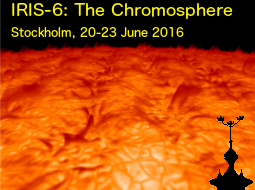Speaker
Ricardo Gafeira
(Max Planck Institute for Solar System Research)
Description
The balloon-borne SUNRISE observatory allows obtaining observations in the UV with
unprecedented temporal stability and spatial resolution. During its second scientific
flight the Sunrise Filter Imager (SUFI) was used to record a time series of
narrow-band intensity images in the Ca II H line lasting for approximately one hour
at a cadence of 7 seconds. This unique data set enabled us to identify and track
small scale fibrils observed in this line and analyse their morphological properties
and their temporal evolution. In a next step, we combined the information extracted
from the identification and tracking of the fibrils in the intensity images with the
spectro-polarimetic data recorded simultaneously with the Imaging Magnetograph
eXperiment (IMaX), to identify the foot-points of these structures and correlate them
with the brightness variation and temporal evolution observed in the Ca II H images.
This correlation allows us to characterise the magnetic configuration of the fibrils,
for example whether they are small-scale loops, or part of a longer magnetic structure.
Author
Ricardo Gafeira
(Max Planck Institute for Solar System Research)

